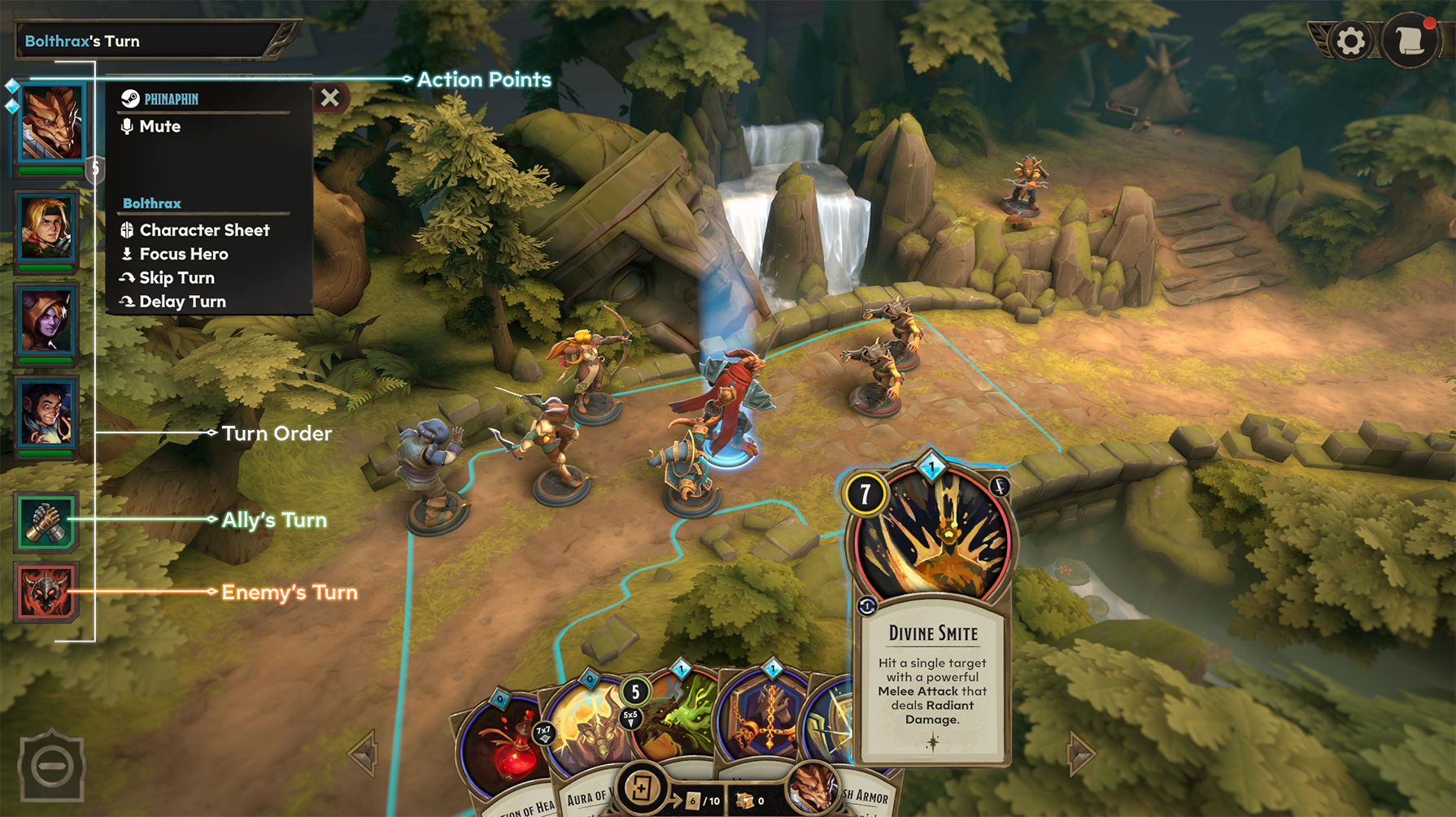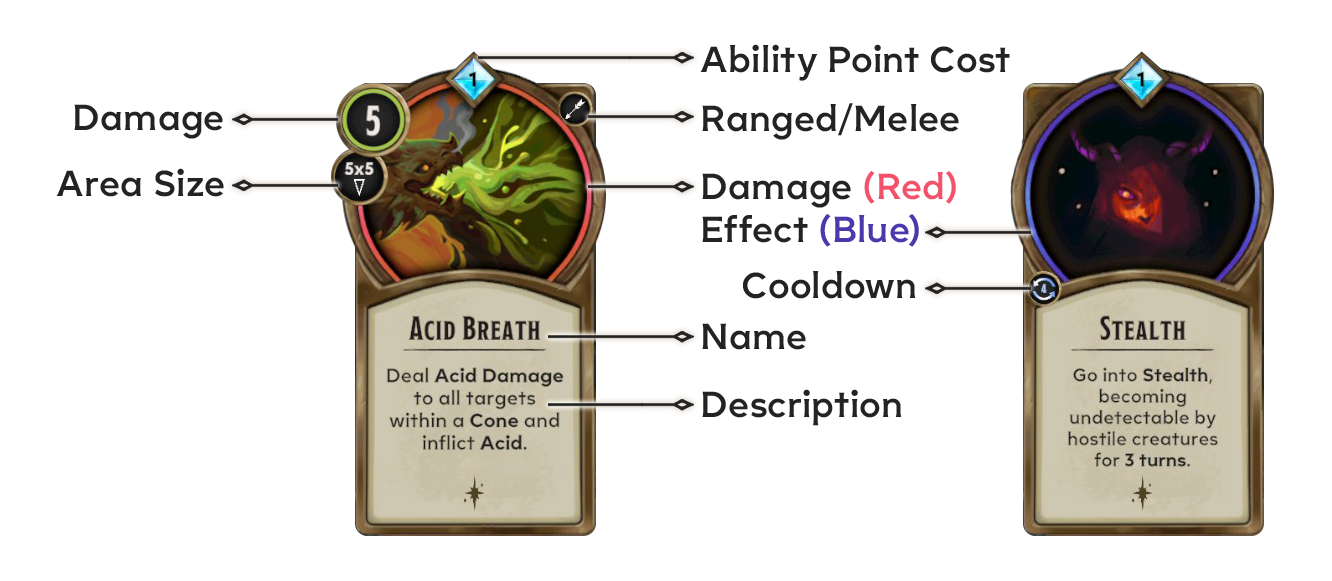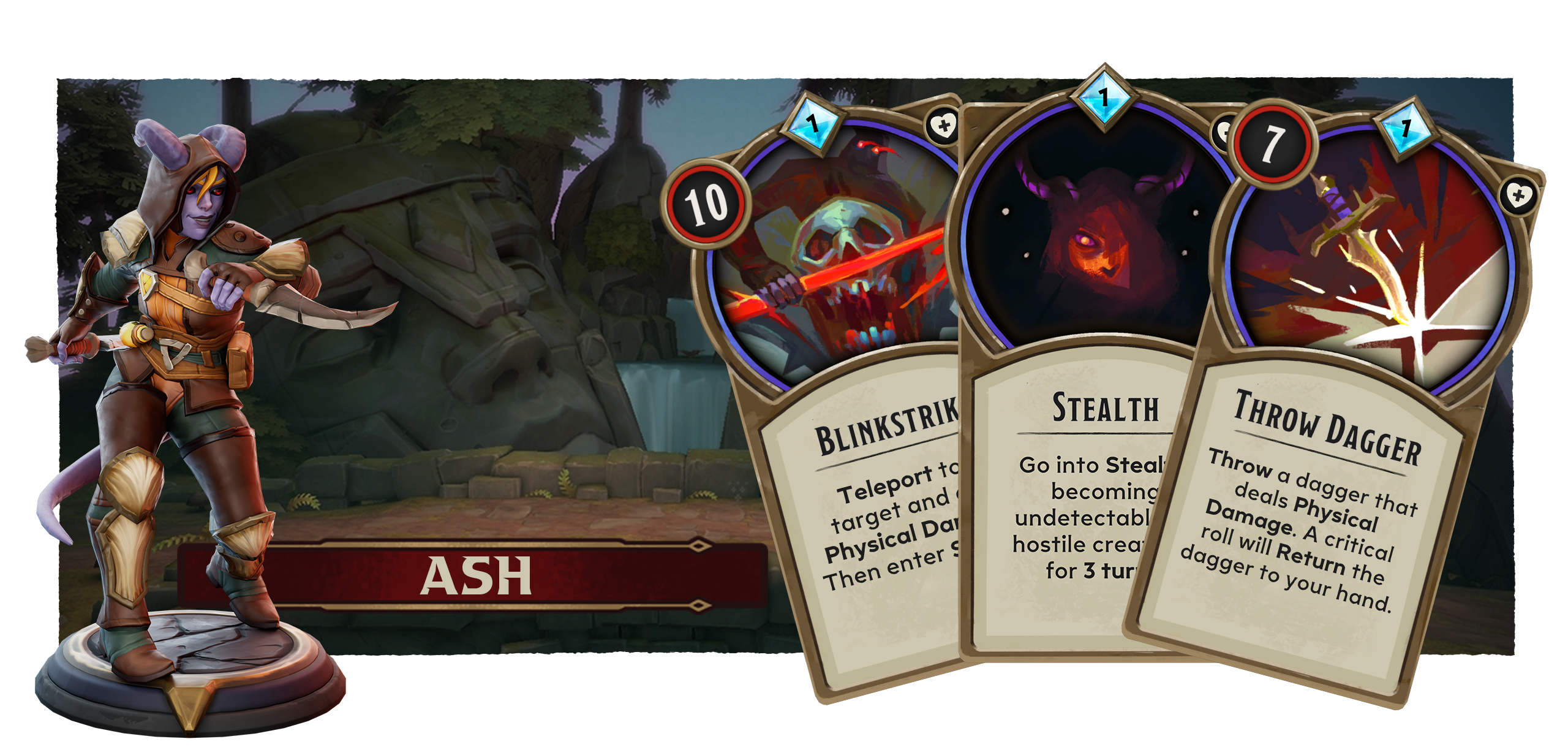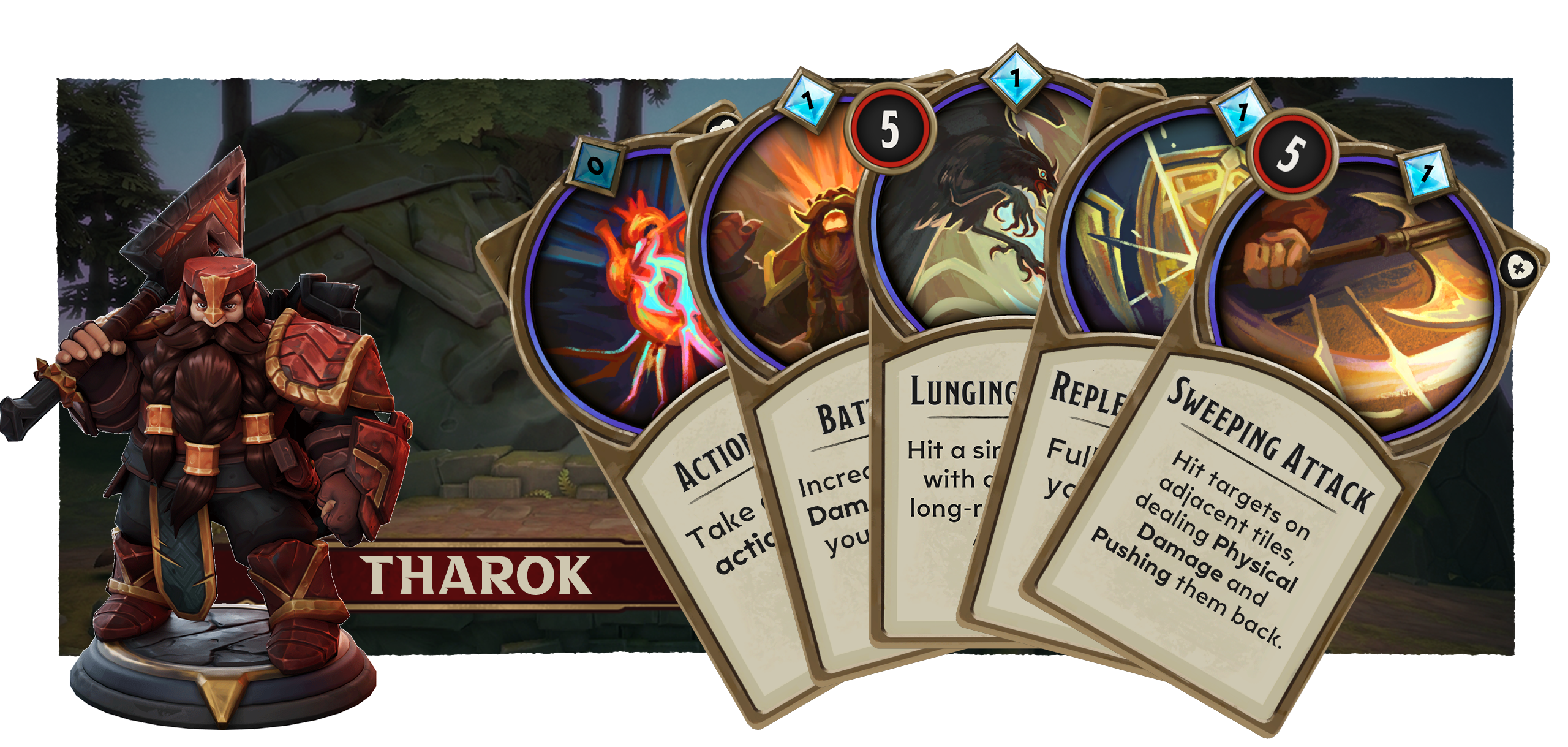How To Play - Demeo x Dungeons & Dragons: Battlemarked

Welcome Adventurers!
Whether you are interested in learning how to grow from fledgling to expert in Demeo x Dungeons & Dragons: Battlemarked or wish to refresh your knowledge a little, we are here to guide you on your quest.

Basics
The first thing needed to prepare you on your journey in Battlemarked is to familiarize yourself with the Demeo Action Roleplaying System - the game system driving the mechanics of the game.

Rounds
Battlemarked is a tactical turn-based game broken down into rounds. At the top of each round, combat flows as follows:
- Player characters (PCs) act based on their turn order
- Friendly minions & non-player characters (NPCs)
- Enemies
Action Points
Each PC gets two Action Points (AP) per turn which can be spent either on movement and melee attacks, or by playing a card from your hand. Upon using all of your available AP, the turn automatically progresses to the next character in the order.
Cards
Cards have an associated cost, displayed as a number at the top of each card inside of a blue diamond. Cards costing 0 actions are free and can be used before the end of the turn without incurring a cost; these include healing potions and various flasks or abilities, such as Aura of Vitality for Bolthrax, the paladin.
Cards have various quick-read information on them that, with practice, lets you quickly identify the particulars of a card’s properties.

- Top-Left Number: Damage that is dealt, color-coded by the type of damage (poison, fire, ice, physical)
- Top-Middle Number: Action Point cost
- Top-Right Icon: Melee (sword), Ranged (arrow), Healing (heart)
- Middle-Left of image: Area of effect size
- Middle-Left of the card: (Replenishing cards only) Number of rounds until next available usage
- Portrait Border: Red signifies an attack, blue/purple signifies beneficial effects
- Name: The card’s name
- Description: The particular rules or mechanics of the card
Delay Turn
When taking a turn before another ally character, you can elect to Delay Turn so long as no actions or cards have been played in the turn. This progresses the turn to the next character and places the delayed character at the end of the turn order. The last character to take a turn cannot use Delay Turn.
Note: While movement costs a single action to move up to your maximum range, it is also possible to perform melee (standard) attacks against your foes by moving your piece over the target. This triggers the move and attack with a single AP cost, rather than two.
Characters
There are six playable characters available in Battlemarked, each with their own class and species combination, starting hand of cards, and default weapon.

Name: Ash
Species: Tiefling
Class: Rogue
Starting Weapon: Daggers
Starting Abilities & Cards: Gas Bomb, Stealth, Throw Dagger
Primary Ability Score: Dexterity
Role: Utility, Damage Dealer, Melee Damage
Strengths:
- Stealth stops Ash being targeted by enemies
- Extra damage when Stealthed or backstabbing enemies
- Scout areas under Stealth
- Set up traps, bombs, and flasks to control the battlemap

Name: Bolthrax Brightscale
Species: Dragonborn (copper)
Class: Paladin
Starting Weapon: Greatsword
Starting Abilities & Cards: Acid Breath (copper dragonborn), Aura of Vitality, Divine Smite, Replenish Armor, Warding Bond
Primary Ability Score: Strength
Role: Tank, Support, Melee Damage
Strengths:
- Powerful offensive abilities, utilizing smite spells
- Melee attacks push some enemies back a square
- Aura abilities provide incredible support

Name: Jessix Copperleaf
Species: Human
Class: Ranger
Starting Weapon: Bow
Starting Abilities & Cards: Arrow, Fire Arrow, Hail of Thorns
Primary Ability Score: Dexterity
Role: Ranged Damage, Damage Dealer, Summons Companions
Strengths:
- Long-range sustained damage with 2x Arrows per turn
- Greater vision range
- Can call nature to her side in the form of an animal companion (wolf or rats)

Name: Lyria Nimara
Species: Elf
Class: Bard
Starting Weapon: Rapier
Starting Abilities & Cards: Bardic Inspiration, Magical Secrets, Sleep, Vicious Mockery
Primary Ability Score: Charisma
Role: Support, Ranged Damage, Crowd Control
Strengths:
- Versatile Jack-of-All-Trades that can cast spells and deal significant melee damage
- Bardic Inspiration provides supporting buffs to allies
- Can be used to double down on status or elemental effects by copying a Spell card from allies

Name: Tharok Kuldelver
Species: Dwarf
Class: Fighter
Starting Weapon: Battleaxe and Shield
Starting Abilities & Cards: Action Surge, Battle Cry, Sweeping Attack, Lunging Attack
Primary Ability Score: Strength
Role: Damage Dealer, Melee Damage
Strengths:
- Strong defense and damage mitigation
- Gap-closing abilities put him in the middle of fights quickly
- Action Surge extends the amount of actions Tharok can take, letting him do more in a turn

Name: Tibby Hopplebock
Species: Halfling
Class: Sorcerer
Starting Weapon:
Starting Abilities & Cards: Fire Bolt, Fireball, Misty Step, Ray of Frost
Primary Ability Score: Charisma
Role: Elemental Magic, Damage Dealer, Ranged Damage
Strengths:
- Access to powerful spells such as Fireball and Chain Lightning
- Fire Bolt and Ray of Frost are both replenished after a set number of turns, allowing sustained elemental damage or effects
- Powerful, long-range relocation spells like Misty Step

Character Creation and Customization
When customizing one of the characters in Battlemarked, elements that can be changed are the:
- Color palette of the miniature
- Name
- Secondary Ability

Each tab of the Abilities section determines each progression tree that the character has access to. The first tab is always related to the Class as defined when selecting a hero to customize. The second tab is the Primary Ability, which is also determined as part of the hero selected based on their Class and in some cases based on the character’s story. These two sections are predefined.
The final tab (Constitution in the attached image) is the Secondary Ability, which is set to a recommended Ability; however, this can be changed to suit your style of play or intended build.
Traits with the card icon in the bottom right corner will add cards to your deck to be drawn during play. When starting out for the first time, it is advised to try the recommended Secondary Ability for each of the heroes, to gain an understanding of the game and how these upgrades might benefit you in subsequent playthroughs.

Ability (Skill) Checks
Skill checks in Battlemarked are handled in a more streamlined fashion compared to tabletop Dungeons & Dragons. When you spend points to upgrade the traits for your key Abilities, these will increase Ability Scores for them.
Upon making a Skill Check in random events or social encounters, these scores will affect the final Difficulty Class (DC)—the number you have to be greater than or equal to for the roll to succeed—meaning the more points you spend in Charisma, for example, the easier a Charisma (Intimidation) Check will become for that character.

Equipment
Equipment is not only the cards that you play; you can also find weapons as you adventure! The weapons work as abilities, giving you extra perks or bonuses, and sometimes they will give cards too, allowing you to tweak your play style. For example, Jessix’s starting longbow also gives the Quick Step—which allows her to move a short distance at no AP cost and find a better angle to attack. Changing this weapon for another will change what benefit is granted, if any.
Weapons are obtained by defeating bosses in the game, allowing you to expand your arsenal with each victory. Some weapons also have the ability to be upgraded by defeating more bosses or finding special weapon chests throughout dungeons.

Ground Hazards & Status Effects
Ground hazards—such as poison, oil, and water—serve as multipurpose gameplay mechanics, depending on the situation. Knowing how to work with them will give you the upper hand when map layouts and fights become more complex and crowded.
On their own, they are at best a zone control mechanic to fill choke points with a hazardous substance; at worst, they are a volatile area waiting for the right elemental effect to trigger increased damage, all the while having a passive effect on you.
Some ground-covering effects have a dual-edge to them. For example, water can be used to douse fire, clear poison clouds, and reduce incoming fire damage when used on a hero; however, when afflicted by the “Wet” condition, that creature will take increased lightning damage, and cold damage causes them to freeze and lose their turn.
Barrels have these similar effects, from explosions to covering an area with water. Heroes and enemies can draw cards that give them the ability to place their own barrels or throw flasks over distances to create a corresponding effect, allowing for a measure of control of the battle map or to prepare for a follow-up combination of elemental spells.

Digging Deeper
Hopefully you find this primer of the basics of play and some of the features new to the Demeo franchise helpful to your first steps into Battlemarked. There are more advanced tricks, combinations, and strategies that you will be able to learn and employ to your advantage, and we look forward to seeing the ingenuity that comes from experimenting with the systems we’ve built.
Have you found some neat strategy that wins the day for you every time? Why not join our Discord community to share and learn new strategies alongside other players?
We look forward to seeing how you will play!
—Battlemarked Team
